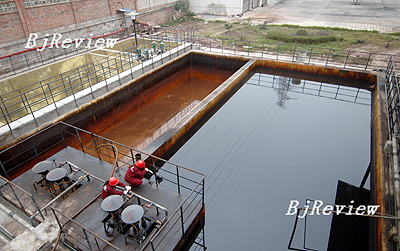|

This is an important year for China not only because of the historical Olympics event but also because the country will significantly reduce pollution with its commitment to cutting up to 2.3 million tons of sulfur dioxide (SO2) emissions and 1.3 million tons of chemical oxygen demand (COD), according to a recent plan outlined by the State Environmental Protection Administration (SEPA).
SEPA Director Zhou Shengxian said at a high-profile environment meeting in late January that this year's mission is to reduce SO2 by 6 percent and COD by 5 percent based on their 2005 levels, which serves as the base for the environmental goals of the 11th Five-Year Plan (2006-2010).
"Industrial restructuring will play a fundamental role in curbing pollution," Zhou said. By the end of 2010, the plan is to bring down both SO2 and COD levels by 10 percent, based on 2005 figures.
Acknowledging the serious environmental challenge facing the country, Zhou noted that the fight against pollution is far from over. SEPA figures showed that last year, the quality of more than 26 percent of water runoff was worse than grade V-a level unfit for human contact. The air quality in cities on more than 100 days was below grade II, the level at which it is considered healthy for humans.
To fulfill the commitment, more high energy consuming and high polluting power plants have to be shut down this year, including a number of small-scale thermal power plants with a combined output of 13 gw, steel plants with a total capacity of 6 million tons, cement plants with a combined output of 50 million tons, iron production facilities with a total capacity of 14 million tons, and papermaking factories producing a combined 1 million tons, said the top SEPA official.
"This phase-out plan, if achieved by the end of this year, will help China reduce its emissions of SO2 by 600,000 tons and cut COD by 400,000 tons," Zhou said, also indicating that several key eco-friendly projects will soon be implemented.
Last year the country made progress in its green battle against COD due to measures taken by the Central Government and environmental agencies. The density of COD in water resources was 6.5 mg per liter, down 7 percent on 2006.
In 2007, a reduction in SO2 emission also prevented 100,000 square km of land from suffering acid rain. The number of blue-sky days with good air quality was also up on the previous year.
The plan aims to enhance sewage-handling capacity as well. The country's urban wastewater treatment capacity is to be increased by 12 million tons a day, which will cut COD by 600,000 tons. Meanwhile, various industries will be required to improve their wastewater treatment capacities contributing to a COD reduction, of 200,000 tons a year.
The use of sulfur scrubbers to clean emissions will be emphasized, the plan said. New thermal power generation units with a combined capacity of 30 gw will be installed with sulfur removal capabilities, leading to an SO2 emission cut of 1.5 million tons.
Pushed by the critical environmental challenge caused by China's rapid economic development, SEPA has taken greater initiatives to protect the environment, targeting its tough measures not only toward domestic enterprises but also foreign ones.
Since last November, SEPA has conducted special environmental protection post-checkups on 130 multinational companies that had broken environmental laws in 2004-2007, across 19 provinces, autonomous regions and municipalities.
This year SEPA made more progress by starting to work with the financial sector to create an international benchmark for green credit.
SEPA signed a deal with the International Finance Corp. (IFC) on January 25 in Beijing to introduce the Equator Principles to China. The principles are a voluntary set of guidelines based on IFC policies to incorporate social and environmental issues into project financing.
China introduced the green loan concept last July as part of its enforcement of eco-friendly economic policies. Communication between environmental monitors and banks saw some plants blacklisted from receiving loans because of their pollution records.
"It proved an effective instrument to curb pollution and lower financial risk," said Yang Chaofei, head of SEPA's policy department. | 